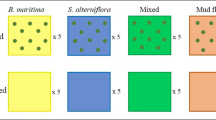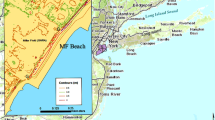Abstract
The black mangrove, Avicennia germinans, occurs sympatric withSpartina alterniflora in coastal Louisiana. Zonation exists alongan elevational gradient with A. germinans dominant at higherelevation creekbanks and S. alterniflora at interior, lowerelevation sites with greater depth and duration of flooding.Establishment of A. germinans seedlings was examined in cagesthat excluded predators and limited horizontal, but not vertical,movement of propagules by the tides and showed that blackmangrove could readily establish in the Spartina zone. Survivalof A. germinans seedlings after one year in cages was notsignificantly different between the two zones, and seedlings weresignificantly taller in the Spartina zone. Thus, neitherinundation per se nor other abiotic factors alone could accountfor the absence of A. germinans in the interior marsh. Althoughpropagules were dispersed into both zones, a net removal ofuncaged propagules from plots in the Spartina zone (–1.3 ± 0.6m-2 d-1) compared to a net addition to plots in the Avicennia zone (+0.5 ± 0.4 m-2d-1) indicated that retention of propagulesdiffered between zones. Causes of mortality were decay (Spartina> Avicennia zone), desiccation (Avicennia > Spartina zone), andpredation (Spartina > Avicennia zone). Although few propaguleswere completely consumed by predators (snails and crabs), damageto the cotyledons promoted decay. The results suggest that tidalaction limits retention and settlement of A. germinans propagulesin the Spartina zone, and a combination of predator damage andfrequent flooding leads to rapid decay of propagules that strandthere.
Similar content being viewed by others
References
Agresti, A. 1990. Categorical Data Analysis. John Wiley and Sons, New York.
Clarke, L.D. and Allaway, W.G. 1993. The regeneration niche of the grey mangrove (Avicennia marina): effects of salinity, light and sediment factors on establishment, growth, and survival in the field. Oecologia 93: 548–556.
Clarke, L.D. and Hannon, N.J. 1967. The mangrove swamp and salt marsh communities of the Sydney District I. Vegetation, soils and climate. Journal of Ecology 55: 753–771.
Clarke, P.J. and Myerscough, P.J. 1993. The intertidal distribution of the grey mangrove (Avicennia marina) in southeastern Australia: The effects of physical conditions, interspecific competition, and predation on propagule establishment and survival. Australian Journal of Ecology 18: 307–315.
Detweiler, T., Dunstan, F.M., Lewis III, R.R. and Fehring, W.K. 1975. Patterns of secondary succession in a mangrove community, Tampa Bay, Florida. pp. 52–81. In: Walsh, G. et al. (eds), Proceedings of the 2nd Annual Conference on Restoration of Coastal Vegetation in Florida, 203 pp.
Eleuterius, L.N. and Eleuterius, C.K. 1979. Tide levels and salt marsh zonation. Bulletin of Marine Science 29: 94–400.
Gosselink, J.G. and Kirby, C.J. 1974. Decomposition of salt marsh grass, Spartina alterniflora Loisel. Limnology and Oceanography 19: 825–832.
Jimenez, J.A. and Sauter, K. 1991. Structure and dynamics of mangrove forests along a flooding gradient. Estuaries 14: 49–56.
Johnston, S.A., Jr. 1983. Preliminary report on Avicennia germinans located on Isle de Chien (Dog Island), Franklin County, Florida. Tropical Ecology 24: 13–18.
Kangas, P.C. and Lugo, A.E. 1990. The distribution of mangroves and saltmarsh in Florida. Tropical Ecology 31: 32–39.
Lopez-Portillo, J. and Ezcurra, E. 1989. Zonation in mangrove and salt marsh vegetation at Laguna de Micoacan, Mexico. Biotropica 21: 107–114.
Lugo, A.E. and Zucca, C.P. 1977. The impact of low temperature stress on mangrove structure and growth. Tropical Ecology 18: 149–161.
McKee, K. L. 1993. Soil physicochemical patterns and mangrove species distribution: reciprocal effects? J. Ecol. 81: 477–487.
McKee, K. L. 1995a. Seedling recruitment patterns in a Belizean mangrove forest: effects of establishment ability and physico-chemical factors. Oecologia 101: 448–460.
McKee, K. L. 1995b. Mangrove species distribution patterns and propagule predation in Belize: an exception to the dominance-predation hypothesis. Biotropica 27: 334–345.
McMillan, C. 1971. Environmental factors affecting seedling establishment of the black mangrove on the central Texas coast. Ecology 52: 927–930.
Osborne, K. and Smith, T.J., III. 1990. Differential predation on mangrove propagules in open and closed canopy forest habitats. Vegetatio 89: 1–6.
Patterson, C.S. 1991. Factors controlling the distribution of the black mangrove, Avicennia germinans L., in a Louisiana mangal/salt marsh community. Ph.D. dissertation, Louisiana State University, Baton Rouge, LA, USA.
Patterson, C.S. and Mendelssohn, I.A. 1991. A comparison of physicochemical variables across plant zones in a mangal/salt marsh community in Louisiana. Wetlands 11: 139–161.
Patterson, C.S., Mendelssohn, I.A. and Swenson, E.M. 1993. Growth and survival of Avicennia germinans seedlings in a mangal/salt marsh community in Louisiana, U.S.A. Journal of Coastal Research 9: 801–810.
Rabinowitz, D. 1978a. Dispersal properties of mangrove propagules. Biotropica 10: 47–57.
Rabinowitz, D. 1978b. Early growth of mangrove seedlings in Panama, and an hypothesis concerning the relationship of dispersal and zonation. Journal of Biogeography 5: 113–133.
SAS User's Guide: Statistics. 1985 Version 5 Edition, SAS Institute, Inc. Cary, NC, USA.
Sherrod, C.L., Hockaday, D.L. and McMillan, C. 1986. Survival of red mangrove, Rhizophora mangle, on the Gulf of Mexico coast of Texas. Contributions in Marine Science 29: 27–36.
Smith, T. J. III. 1987a. Seed predation in relation to tree dominance and distribution in mangrove forests. Ecology 68: 266–273.
Smith, T. J. III. 1987b. Effects of seed predators and light level on the distribution of Avicennia marina (Forsk.) Vierh. in tropical, tidal forests. Estuarine, Coastal and Shelf Science 25: 43–51.
Smith, T. J. III. 1992. Forest structure. pp. 101–136. In: A.I. Robertson and Alongi, D.M. (eds), Tropical Mangrove Ecosystems. Coastal and Estuarine Studies #41. American Geophysical Union, Washington, D.C.
Smith, T. J., III, Chan, H.T., McIvor, C.C. and Roblee, M.B. 1989. Comparisons of seed predation in tropical, tidal forests from three continents. Ecology 70: 146–151.
Tomlinson, P. B. 1986. The Botany of Mangroves. Cambridge University Press, New York.
West, R.C. 1977. Tidal salt-marsh and mangal formations of Middle and South America. pp. 157–166. In: Chapman, V.J. (ed.), Ecosystems of the World, 1. Wet Coastal Ecosystems. Elsevier, Amsterdam.
Author information
Authors and Affiliations
Rights and permissions
About this article
Cite this article
Patterson, S., McKee, K.L. & Mendelssohn, I.A. Effects of tidal inundation and predation on Avicennia germinans seedling establishment and survival in a sub-tropical mangal/salt marsh community. Mangroves and Salt Marshes 1, 103–111 (1997). https://doi.org/10.1023/A:1009923917812
Issue Date:
DOI: https://doi.org/10.1023/A:1009923917812




